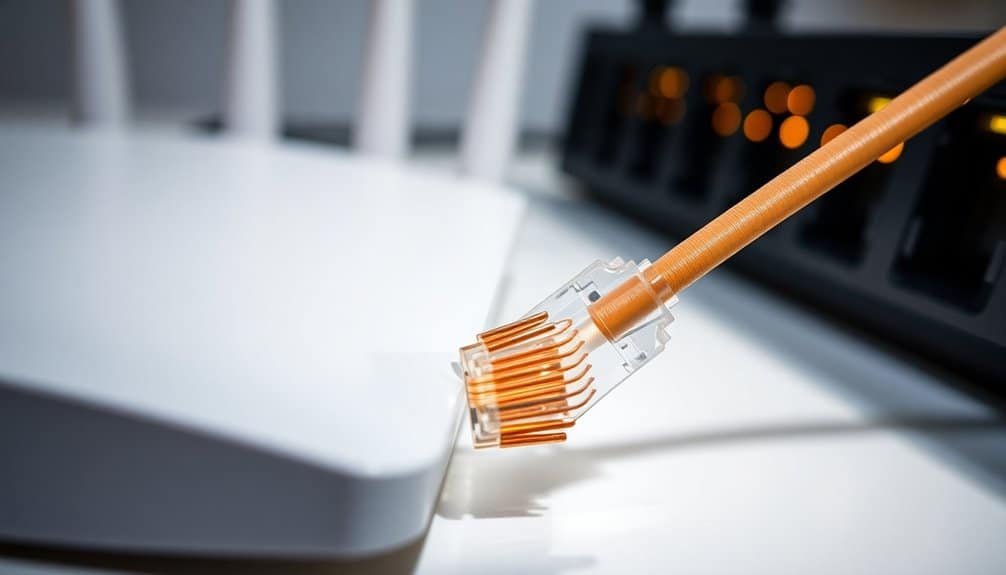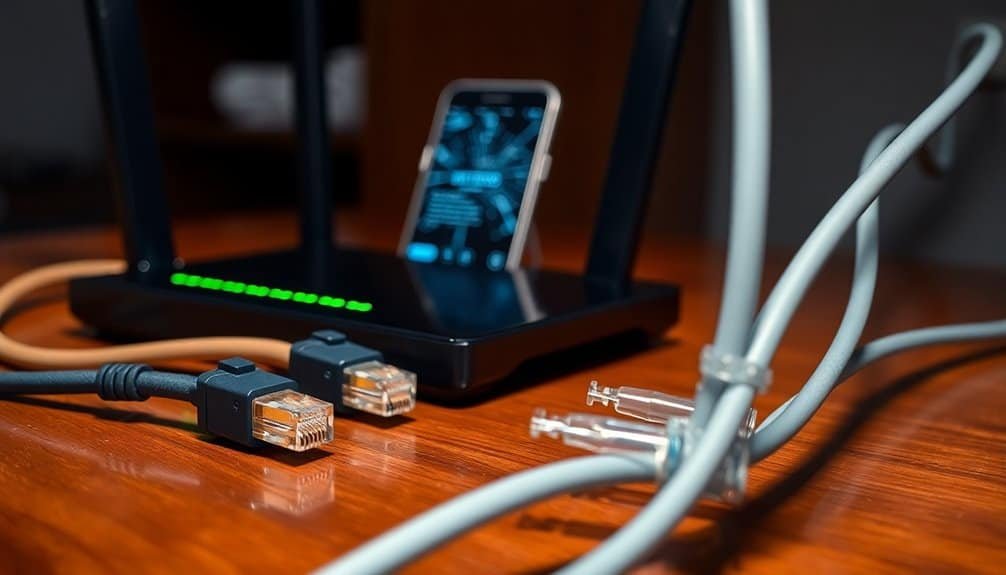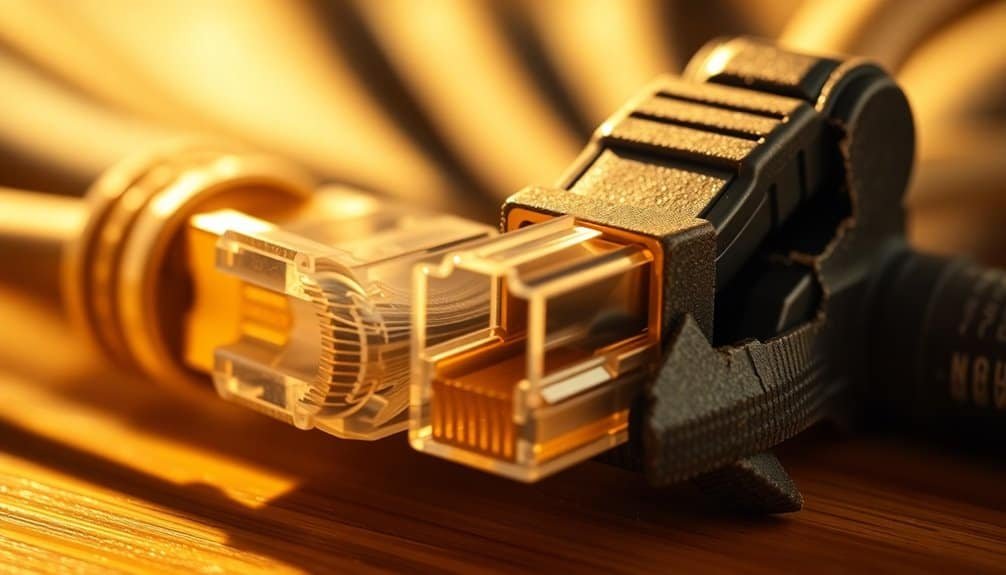Benefits of Switching to Wired Connections
Switching to wired connections boosts network speed with data rates up to 10 Gbps via Ethernet, ensuring consistent performance and reliability even during peak usage. It enhances security by minimizing hacking risks and maintaining data integrity.
Wired connections offer lower latency, ranging from 1-4ms, which is crucial for online gaming and real-time applications. They are also cost-effective, reducing long-term operational expenses.
Disclaimer: As an affiliate, I may collect a share of sales from the links on this page.
Enhanced Speed and Performance

When you switch to a wired connection, you gain access to notably faster data transfer rates. Ethernet cables, especially Cat6A, can reach speeds up to 10 Gbps. In contrast, while Wi-Fi 6 theoretically offers 9.6 Gbps, real-world speeds are often lower. Ethernet guarantees stable, consistent speeds, ideal for high-bandwidth activities like streaming and gaming. Additionally, Ethernet reduces latency greatly, essential for real-time applications. Unlike Wi-Fi, which faces interference and shared bandwidth limitations, wired connections maintain performance. Consequently, for tasks requiring reliable and rapid data transfer, Ethernet proves to be the superior option for your network needs. Ethernet connections provide consistent speeds unaffected by network congestion, making them ideal for scenarios like gaming and file transfers.
Unmatched Reliability and Connectivity
Wired connections offer significant advantages in reliability that outpace their wireless counterparts. They maintain high performance during peak usage, as demonstrated during the COVID-19 pandemic when cable networks remained stable. In critical environments, such as smart buildings, wired networks guarantee consistent connectivity without disruptions. They also provide superior stability, reducing downtime and improving overall network efficiency. Additionally, with the surge in internet usage due to COVID-19, consumers have heavily relied on wired connections to ensure seamless connectivity for remote work and educational activities.
With less susceptibility to interference, wired connections deliver reliable performance across multiple devices. This reliability supports applications requiring real-time data and high bandwidth, making wired connections crucial for environments like gaming, streaming, and business operations where uninterrupted service is essential.
Improved Security for Sensitive Data

Utilizing wired connections greatly enhances security for sensitive data, as they confine data transmission to physical cables and reduce the risk of unauthorized access.
Wired networks minimize hacking risks, making interception considerably tougher. They provide superior data encryption compared to wireless networks, which can be compromised.
Physical access control means that unauthorized access is challenging, as one must physically reach the network. You also gain better control over access points, lowering the chance of unwanted devices connecting.
Additionally, wired connections are less vulnerable to interferences, ensuring consistent data integrity and safeguarding your confidential information effectively against cyber threats. This is particularly important in high-demand applications where wired connections deliver lower latency and improved performance.
Reduced Latency for Real-Time Applications
In real-time applications, reducing latency is essential for maintaining a smooth user experience. Wired connections typically offer latency ranging from 1-4ms, vastly outperforming wireless networks, which average 7-25ms. This lower latency is vital for online gaming, video conferencing, and real-time data processing, where quick responses considerably impact performance.
Additionally, wired networks provide stable connections, immune to interference from other devices, ensuring consistent performance. The reliability of wired connections eliminates disconnections during critical interactions, allowing for uninterrupted communication.
Fundamentally, wired connections enhance timing and responsiveness, giving you a competitive edge in real-time scenarios.
Cost-Effectiveness and Maintenance Benefits

While many businesses weigh the initial costs, switching to wired connections often proves cost-effective in the long run.
Wired networks incur significant upfront expenses for cabling and installation, yet they reduce long-term operational costs. Unlike wireless connections, which face frequent repairs due to signal interference, wired systems require less maintenance and downtime.
You’ll also find that troubleshooting wired setups is simpler, as they’re not hampered by complexities associated with wireless networks.
Ultimately, while the initial investment can be high, the stability and lower ongoing costs of wired connections often lead to better long-term value for businesses.
Scalability for Future Growth
Scalability is a critical factor businesses must consider when moving to wired networks.
Wired networks often face expansion challenges due to high costs associated with infrastructure upgrades, such as cables and switches. Ethernet, the backbone of many wired systems, struggles with scalability, relying heavily on broadcasts that limit its load balancing capabilities.
Despite these challenges, you can implement strategies like modular designs and IPv6 adoption to manage growth effectively.
Integrating elastic cloud services can further enhance scalability, allowing you to adjust resources as your network demands increase.
Ultimately, planning for future scalability is essential for maintaining robust wired connections.
Flexibility in Network Management
A wired network offers significant flexibility in managing resources effectively. You can allocate bandwidth granularly, directing necessary resources to critical applications, thereby enhancing performance.
With centralized management tools, monitoring becomes streamlined, reducing administrative overhead associated with resource allocation. Wired connections support dynamic resource assignments, adapting to your changing organizational needs.
Troubleshooting is simplified; you can verify physical connections quickly, isolating issues without hassle. This streamlined approach to maintenance lessens network downtime.
Furthermore, wired networks improve overall security by providing isolation and better monitoring, essential for compliance with security standards. This flexibility makes wired networks a strong choice for efficient management.
Elimination of Wi-Fi Dead Spots
Eliminating Wi-Fi dead spots is essential for maintaining a reliable and efficient network. Wired connections offer stability, preventing signal loss from physical barriers like walls and floors. They deliver high-speed data transfer, ensuring faster connections without the chaos of multiple access points.
By reducing electronic interference and network congestion, you gain clearer signals. Although the installation cost can be higher initially, wired setups lower long-term expenses by minimizing equipment upgrades.
Additionally, wired connections enhance security, making them less vulnerable to unauthorized access. Overall, switching to wired connections eliminates frustrating dead spots and optimizes your network’s performance.
Frequently Asked Questions
What Types of Cables Are Best for Wired Connections?
For wired connections, you’ll want to evaluate Cat5e for basic tasks, Cat6 for faster speeds, and Cat6a or higher for high-traffic environments. Each option balances performance, cost, and compatibility based on your needs.
How Can I Install a Wired Network Myself?
To install a wired network yourself, plan your layout, gather necessary tools, run cables carefully, terminate connections accurately, and test everything thoroughly. By following these steps, you’ll have a reliable network setup.
Are Wired Networks Energy Efficient?
Imagine a river flowing steadily; wired networks maintain a consistent energy flow, reducing overhead compared to their wireless counterparts. You’ll find these connections not only efficiently transmit data, but also stabilize energy consumption over time.
Can I Connect Wireless Devices to a Wired Network?
Yes, you can connect wireless devices to a wired network by using a wireless access point or wireless bridge. These devices enable your wireless gadgets to join the existing wired setup seamlessly and expand your network’s reach.
What Troubleshooting Steps Are Needed for Wired Networks?
To troubleshoot wired networks, you need to check power, verify cables, reboot devices, inspect the Device Manager, examine IP and DNS settings, perform ping tests, and update drivers if necessary for ideal connectivity.
Conclusion
Switching to wired connections offers significant advantages. Experience enhanced speed, unmatched reliability, and improved security for sensitive data.
Latency drops, ensuring real-time applications run smoothly. Enjoy cost-effectiveness with reduced maintenance needs.
As your network grows, scalability becomes effortless, enabling easy management. Eliminate frustrating Wi-Fi dead spots and embrace wired efficiency.

